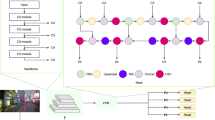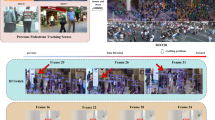Abstract
Robust detection of small targets is very important in IRST (Infrared Search and Track). This paper presents a novel mathematical method for the incoming target detection problem in cluttered background motivated from the robust properties of human visual system (HVS). The HVS shows the best efficiency and robustness for an object detection task. The robust properties of the HVS are contrast mechanism, multi-resolution representation, size adaptation, and pop-out phenomena. Based on these facts, a plausible computational model integrating these facts is proposed using Laplacian scale-space theory and Tune-Max based optimization method. Simultaneous target signal enhancement and background clutter suppression is achieved by tuning and maximizing the signal-to-clutter ratio (TMSCR) in Laplacian scale-space. At the first stage, the Tune-Max of the signal to background contrast produces candidate targets with adapted scale. At the second stage, the Tune-Max of the signal-to-clutter ratio (SCR) produces maximal SCR which is used to pop-out detections. Experimental evaluation results for the incoming target sequence validate the upgraded detection capability of the proposed method compared with the Top-hat method at the same false alarm rate. Experimental results for the six kinds of cluttered background images show that the proposed TMSCR produces less false alarms (4.3 times reduction) compared to the Top-hat at the same detection rate.

















Similar content being viewed by others
References
R. C. Warren, Detection of distant airborne targets in cluttered backgrounds in infrared image sequences, Ph.D. Thesis, University of South Australia, (2002).
J. Barnett, “Statistical analysis of median subtraction filtering with application to point target detection in infrared backgrounds,” Proceedings of SPIE 1050, 10–15 (1989).
V. T. Tom et al., “Morphology-based algorithm for point target detection in infrared backgrounds,” Proceedings of SPIE 1954, 2–11 (1993).
S. D. Deshpande et al., “Max-mean and max-median filters for detection of small-targets,” Proceedings of SPIE 3809, 74–83 (1999).
R. Nitzberg et al., “Spatial filtering techniques for infrared (IR) sensors,” Proceedings of SPIE 178, 40–58 (1979).
W. A. C. Schmidt, “Modified matched filter for cloud clutter suppression,” IEEE Trans Pattern Anal Mach Intell 12 (6), 594–600 (1990).
D. J. Gregoris, S. K. W. Yu, and S. Tritchew, “Detection of dim targets in FLIR imagery using multiscale transforms,” Proceedings of SPIE 2269, 62–71 (1994).
G. Wang, T. Zhang, L. Wei, and N. Sang, “Efficient method for multiscale small target detection from a natural scene,” Optical Engineering 35 (3), 761–768 (1997).
Z. C. Wang, J. W. Tian, J. Liu, and S. Zheng, “Small infrared target fusion detection based on support vector machines in the wavelet domain,” Optical Engineering 45 (7), 076401 (2006).
R. VanRullen, “Visual saliency and spike timing in the ventral visual pathway,” Journal of Physiology (Paris) 97, 365–377 (2003).
B. A. Wandell, Foundations of Vision (Sinauer Press, Suderland, Massachusetts, 1995).
J. Fiser, S. Subramaniam, and I. Biederman, “Size Tuning in the absence of spatial frequency tuning in object recognition,” Vision Research 41 (15), 1931–1950 (2001).
H. D. Tagare, K. Toyama, and J. G. Wang, “A Maximum-likelihood strategy for directing attention during visual search,” IEEE Transactions on Pattern Analysis and Machine Intelligence 23 (5), 490–500 (2001).
B. Zhang, T. Zhang, Z. Cao, and K. Zhang, “Fast new small-target detection algorithm based on a modified partial differential equation in infrared clutter,” Optical Engineering 46 (10), 106401 (2007).
J.-P. Ardouin, “Point source detection based on point spread function symmetry,” Optical Engineering 32 (9), 2156–2164 (1993).
T. Lindeberg, “Feature detection with automatic scale selection,” International Journal of Computer Vision 30 (2), 77–116 (1998).
K. Mikolajczyk and C. Schmid, “Indexing based on scale invariant interest points,” 8th IEEE International Conference on Computer Vision (ICCV’01) Vol. 1, 525–531 (2001).
S. Kim and I. S. Kweon, “Biologically motivated perceptual feature: generalized robust invariant feature,” LNCS 3852, 305–314 (2006). ACCV’06.
D. G. Lowe, “Object recognition from scale invariant features,” 7th IEEE International Conference on Computer Vision (ICCV’99), 1150–1157 (1999).
S. Se, et al., “Vision-based Mobile Robot Localization using Scale-Invariant Features,” IEEE International Conference on Robotics and Automation (ICRA’01), 2051–2058 (2001).
T. Netsch and H.-O. Peitgen, “Scale-space signatures for the detection of clustered microcalcifications in digital mammograms,” IEEE Trans. on Medical Imaging 18 (9), 774–786 (1999).
C. Cadieu et al., “A model of V4 shape selectivity and invariance,” Journal of Neurophysiology 98, 1733–1750 (2007).
W. Peizhi et al., “A method for automatic infrared point target detection in a sea background based on morphology and wavelet transform,” Proceedings of SPIE 5286, 248–253 (2003).
J.-H Luo, H.-B. Hi, and J. Liu, “An algorithm based on spatial filter for infrared small target detection and its application to an all directional IRST system,” Proceedings of SPIE 6279, (2007).
Z. Chen et al., “Small target detection algorithm based on average absolute difference maximum and background forecast,” International Journal of Infrared and Millimeter Waves 28, 87–97 (2007).
A. Toet and T. Wu, “Small maritime target detection through false color fusion,” Proceedings of SPIE 6945, (2008)
Author information
Authors and Affiliations
Corresponding author
Rights and permissions
About this article
Cite this article
Kim, S., Yang, Y., Lee, J. et al. Small Target Detection Utilizing Robust Methods of the Human Visual System for IRST. J Infrared Milli Terahz Waves 30, 994–1011 (2009). https://doi.org/10.1007/s10762-009-9518-2
Received:
Accepted:
Published:
Issue Date:
DOI: https://doi.org/10.1007/s10762-009-9518-2




